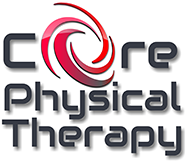Chicago’s Top Rated Local® Physical Therapy
Whether it is Passive, Active, or Both, Keep Stretching! – Dr. Lauren Schnidman, PT, DPT
There are many ways that stretching is incorporated into physical therapy rehabilitation for a variety of orthopedic conditions and injuries that we treat at Core PT. Physical therapists prescribe stretching to increase muscle length and joint range of motion (ROM) or to facilitate proper alignment of collagen fibers as the healing process occurs. Stretching can also decrease pain associated with a musculoskeletal condition such as a herniated disc or following arthroscopic knee surgery.
Although the benefits of incorporating stretching into one’s exercise program are clear, the “best” type of stretching is based on a variety of factors. As is true with most treatments, selection and results are based on the individual patient and are affected by variables such as gender, pain tolerance, orthopedic condition, general mobility, and compliance.3
Recent research has looked into the effectiveness of various types of stretching, specifically active versus passive stretching, and compared how much they improved hamstring flexibility and thus joint ROM. Much of the research has focused on the hamstring muscles, likely due to the ease of measuring and common presentation of tight hamstrings in a clinical setting and in the general population. Passive stretching is defined as “a form of static stretching in which an external force exerts upon the limb to move it into the new position”3. This external force could include assistance from a partner, a strap, gravity, or a person’s body weight. On the other hand, active stretching is when a muscle is stretched by actively contracting its opposing or antagonist muscle.
Meroni et al. (2010) compared active stretching with static passive stretching of the hamstrings. The study assessed hamstring flexibility following 3 weeks of stretching and then 6 weeks (performed twice a day, four days a week). In this study, it was found that the group who performed active stretching of the hamstrings had a significant increase in ROM relative to the passive stretching group following both 3 weeks and 6 weeks of stretching. This was the outcome despite the fact that the total duration of the passive stretching session lasted four minutes longer than that of the active stretching session. In addition, four weeks following the conclusion of the study, a subset of the initial group was reevaluated. Results demonstrated that the active stretching group maintained more than a 6 degree ROM improvement, while the passive stretching group maintained a 0.1 degree ROM improvement.2
Fasen et al. (2010) also compared active stretching of the hamstring versus passive stretching in a randomized control trial. Four different techniques were used; two active stretches and two passive stretches, with a control group (no stretching routine) assessed as well. The study assessed evaluated the participant’s hamstring flexibility at the four and 8 week mark following initiating of stretching (performed five days a week). Results of the study demonstrated that both active and passive stretching is more effective in increasing hamstring flexibility than the control group. Although the study demonstrated that at the four week mark, three of the groups (two performing active hamstring stretches, one performing one of the passive stretches) showed improvement in hamstring flexibility, the two active stretching groups showed the greatest improvement. However, interestingly enough, the group that performed the passive stretch and showed improvement at four weeks, achieved the greatest gain in hamstring flexibility at the eight week conclusion of the study.1
Based on these studies and more, it can be concluded that six to eight weeks of stretching, either passively or actively, is effective in improving hamstring flexibility as well as other muscle groups. Clinically, stretching is often proscribed twice daily over a six to eight week period for maximum gains. Once flexibility goals have been met, frequency of stretching can be decreased. The duration and repetitions of a particular stretch tend to be at the discretion or clinical judgement of the clinician.
The American College of Sports Medicine (ACSM) recommends individuals should perform passive or active stretching following a light aerobic warm-up (to increase blood flow and warm muscles up), at least 2 to 3 days per week. It is recommended that each stretch is held for a duration of 15-30 seconds and repeated 2 to 4 times.
Stretching is an important component of both physical therapy treatment and as part of maintaining general mobility. Both active and passive stretching are effective in increasing flexibility, depending on the patient and clinician preference, one type of stretch may be more beneficial than the other in particular cases. Please seek guidance from a physical therapist or other medical professional prior to initiating a stretching routine for maximum benefits and to decrease the likelihood of injury.
Reference:
- Fasen, J.M., O’Connor, A.M., Schwartz, S.L., et al.(2010). A Randomized Controlled Trial of Hamstring Stretching: Comparison of Four Techniques. Journal of Strength and Conditioning, 23(2), 660-667.
- Meroni, R., Cerri, C.G., Lanzarini, C., et al. (2010). Comparison of Active Stretching Technique and Static Stretching Technique on Hamstring Flexibility. Clinical Journal of Sports Medicine, 20(1), 8-14.
- Page, P. (2012). Current Concepts in Muscle Stretching for Exercise and Rehabilitation International of Journal Sports Physical Therapy, 7(1), 109–119.

